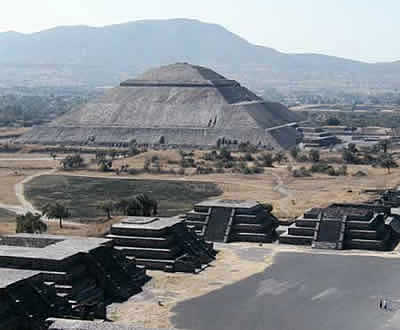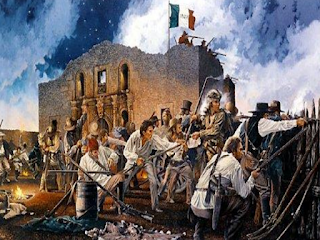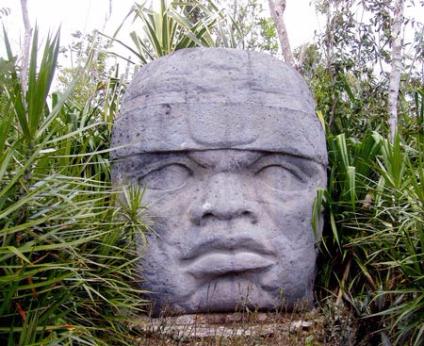 |
| Teotihuacán |
Located some 25 miles northeast of Mexico City in the Basin of Mexico, the massive ruins of the great city of Teotihuacán have long puzzled and intrigued observers. Despite more than a century of archaeological investigation, many mysteries remain about the people who built, ruled, and lived in this vast urban complex. The city was founded in the first century b.c.e., just northeast of Lake Texcoco, which lay at the basin’s center.
Its builders were most likely the former inhabitants of the ancient ceremonial center of Cuicuilco, at Lake Texcoco’s southwest corner, which was destroyed in the eruption of the volcano Xitle around 50 b.c.e. Construction on Teotihuacán began soon after the abandonment of Cuicuilco. The city flourished for the next 600 years, dominating most of the central highlands, before its partial destruction and abandonment around 650 c.e.
The city’s civic and ceremonial core was built in stages, from its beginnings in the first century b.c.e. to its completion by 300 c.e. Carefully designed in a grid-like pattern, the core was dominated by several towering structures connected by a broad avenue: the massive Pyramid of the Sun; the slightly less imposing Pyramid of the Moon; the Temple of Quetzalcoatl (Plumed, or Feathered, Serpent); and the large open-air Citadel. Scholars offer varying interpretations of its builders’ intentions regarding its orientation, with the Avenue of the Dead at 15.5 degrees west of south.
Some argue that it is aligned with solar equinoxes; others, with the constellation Pleiades; others, with the nearby Cerro Gordo volcano; still others have proposed mathematical relationships between the city’s orientation and the sacred 260-day calendar. All agree that its exacting alignment carried deep meaning for its designers and builders.
Its largest and oldest vertical structure, the massive Pyramid of the Sun, was built over a series of caves (discovered in 1971) whose interior chambers were modified and used extensively during the pyramid’s construction phase (1–150 c.e.).
In Mesoamerican mythology caves were linked to the underworld, the dwelling place of the gods, and the origin of creation, suggesting that the pyramid’s location held profound cosmological significance to its designers.
Estimates of the city’s population range from a low of 80,000, to a high of 200,000. During its first century its population grew rapidly, reaching perhaps 80,000 by 150 c.e., with many thousands of people from the Basin of Mexico migrating to the city.
Growth slowed in subsequent decades, with the city’s population reaching its height probably around 200 c.e. In the 200s and 300s a series of more than 2,000 apartment or residential compounds were built to house the city’s huge population.
The sizes and qualities of these compounds varied considerably, suggesting an intricate system of socioeconomic stratification based on wealth, occupation, status, and lineage. Most scholars agree that persons claiming a common lineage inhabited these compounds.
Different districts or neighborhoods within the city also varied widely. In some areas, specialized craft or artisan workshops predominated. Elsewhere, distinct ethnic enclaves are evident, most notably, a cluster of some dozen compounds evidently inhabited by Oaxacans from Monte Albán.
A "merchant’s neighborhood" has been identified near the city’s eastern perimeter. Throughout much of the city, however, it is difficult to identify specific qualities that defined its spatial demographics. While the remnants of walls can be found in various parts of the city, there is no evidence that the city as a whole was walled. An estimated two-thirds of the city’s inhabitants worked in agriculture, in the fields surrounding city, with the remainder engaged in various types of craft production.
The inhabitants of Teotihuacán employed a system of notational signs but had no system of writing comparable to the Maya during this same period. Scholars have identified no grammatical or phonetic elements in the notational system and thus do not know what languages its inhabitants spoke or what they called themselves.
Some scholars have proposed that its rulers sought to create a secretive, mysterious symbolism; others suggest that the signs’ meanings were probably clear to their creators and those who viewed them. The artistic style at Teotihuacán is repetitive, uniform, and somewhat stiff, in sharp contrast to the great variability of styles and motifs among the Maya city-states.
Religion was practiced in at least two distinct spheres: at the level of the household and village and at the level of the state. Village- and household-level religious practices focused on ancestors and deities linked to specific lineages. There is no evidence that these household- and village-level religious practices were in conflict with the state or that there was any organized or lower-class resistance to the state or ruling groups.
State religion was very distinct from village-level religion, emphasizing especially the cult of the Feathered Serpent, most graphically expressed in the Temple of Quetzalcoatl, with its hundreds of huge sculpted heads gracing its massive walls and stairs.
Other major state deities included what is commonly called Tlaloc, the rain god (though interpretations differ on whether this was indeed Tlaloc), the storm/war god, various death and underworld gods, and what E. Pasztory has termed the Great Goddess.
State religion focused on legitimizing the dominance of ruling groups and providing ideological underpinning for the state and its political, military, and ideological dominion within the Basin of Mexico and beyond. This was a highly stratified and militarized society with both extensive and intensive military capacities.
The city dominated the Basin of Mexico, though probably not much beyond it, and regardless of the extent of its direct rule, it carried enormous ideological prestige throughout Mesoamerica.
Perhaps providing a template for the later Aztec military, Teotihuacán’s armies were divided into military orders associated with particular creatures, such as the eagle and jaguar. Its military forces consisted of both commoners and elites that fought in disciplined groups and were highly effective in their use of dart- and spear-throwers (atlatl) and obsidianstudded clubs.
The city’s impressive military capacities and ideological prestige worked together to facilitate exchange and trade relations with neighboring polities. Trade routes, as far south as Central America and as far north as the present-day U.S. Southwest, linked the city to all of Mesoamerica’s significant polities.
Long-distance trade was especially active in prestige items, such as shells, ceramics, obsidian, mica, hematite, jade, turquoise, and cinnabar. Marketplaces within the city were especially important, some suggesting that the Great Compound was also the city’s central marketplace, with cacao serving as a form of currency.
Ritual human sacrifice was practiced at Teotihuacán, though the practice is depicted in the city’s artwork principally through portrayals of human hearts, some impaled on knives. Skeletons of sacrificial victims have been unearthed in the Pyramid of the Sun, the Temple of Quetzalcoatl, and other buildings.
The decline of the great city was rooted in longterm ecological crises, particularly water shortages, deforestation, and soil degradation, trends exacerbated by a series of invasions or attacks by nomadic or seminomadic peoples from the north. Between 500 and 600 these deleterious ecological processes had become irreversible.
Around 650 much of the city was destroyed by fire, probably by external assailants, and most of its buildings and compounds were abandoned. The core ceremonial area around the temples saw the greatest destruction, suggesting a conscious effort to incapacitate the city’s ritual and ideological power. By 750 the city was completely abandoned.
Some six centuries later, upon their arrival into the Basin of Mexico from the northern deserts, the Aztec would look upon the ruins of Teotihuacán as the dwelling place of the gods. Today Teotihuacán remains one of Mexico’s most popular tourist attractions.


















